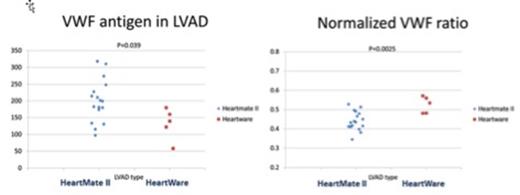Abstract
Background: Von Willebrand factor (VWF) is a multimeric glycoprotein synthesized in endothelium and megakaryocytes. Elevated total VWF antigen has been associated with arterial thrombosis, while in patients with left ventricular assist devices (LVAD), loss of high molecular weight multimers is associated with spontaneous bleeding. We hypothesized that the lower rotational speed of the Heartware LVAD would be associated with less severe disruption of VWF.
Methods: A total of 22 patients were included. We compared samples from a) 17 patients with Heartmate II LVAD (HM II), 76% male, median age 67 (54-73) years, 24% non-white, 45 (33-59) months after implant, with b) 5 patients with Heartware (HW) LVAD, all male, age 64 (59-65) years, 20% non-white, 27 (14-29) months after implant. All patients received warfarin. All HW patients took aspirin, while 82% of HM II patients took aspirin. Samples were analyzed for VWF antigen, activity, platelet function analyzer-100 collagen adenosine diphosphate closure time (PFA) and VWF multimers by gel electrophoresis. Multimers were assessed qualitatively and quantitatively by dividing mers > 15 by mers 2-15 (multimer ratio) and with a normalized multimer ratio (multimer ratio of patient / normal plasma control from the same gel).
Results: Although flow rates did not differ significantly between HM II and HW, 5.2 (4.6-6.5) versus 4.3 (4.2-5.4) liters per minute respectively, rotational speeds were very different, mean 9472 versus 2680 rpms, p<0.0001). There were no differences in hemoglobin, hematocrit, or platelet count at the time of sampling. Qualitative VWF multimers were abnormal in all patients, and PFA was non-clotting in 88% of HM II patients and 80% of HW patients. VWF activity to antigen ratio was not different: HM II 0.68 (0.63-0.74) versus HW 0.70 (0.63-0.71). However, VWF antigen was significantly higher in HM II patients, 199 (174-227) compared to HW, 139 (122-160), p=0.039 and the normalized VWF multimer ratio was significantly lower, suggesting greater loss of high molecular weight multimers in HM II, 0.43 (0.41-0.48) compared to HW, 0.53 (0.48-0.56), p=0.0025 (figure).
Conclusion: The lower rotational speed associated with the Heartware LVAD appears to produce less elevation of VWF antigen, and slightly less loss of VWF high molecular weight multimers compared to the Heartmate II LVAD. Additional studies are needed to describe whether or not lower pump thrombosis rates and rates of spontaneous bleeding are associated with these differences.
No relevant conflicts of interest to declare.
Author notes
Asterisk with author names denotes non-ASH members.


